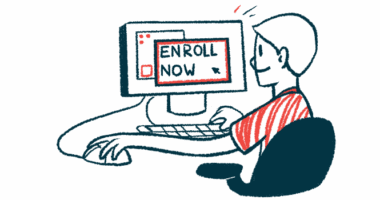PGN-ED051, skipping exon 51, showing benefits in Phase 2 trial
Potential treatment aims to be more efficient, quickly and at lower doses

A low dose of PGN-ED051, PepGen’s investigational exon 51-skipping therapy, safely increased dystrophin protein levels in people with Duchenne muscular dystrophy (DMD), according to early Phase 2 clinical trial data.
The therapy’s effects either were comparable to or greater than what has been observed in studies of other exon 51-skipping therapies at a similar dose level, PepGen reported.
With these findings in the 5 mg/kg dosing group, the CONNECT1-EDO51 (NCT06079736) study has begun testing higher treatment doses. Initial results from a next group, treated at 10 mg/kg, are expected in early 2025. The ongoing and open-label trial still may be recruiting eligible male patients, ages 8 and older, at sites across Canada.
“We are encouraged by the early data from our CONNECT1 clinical trial of PGN-EDO51 in people with DMD,” James McArthur, PhD, president and CEO of PepGen, said in a company press release. “We are optimistic about the possibility that higher levels of dystrophin production will be observed in the 10 mg/kg cohort.”
Exon 51 skipping therapies can treat about 13% of all with Duchenne MD
Insights from CONNECT1, McArthur added, will be used to optimize another Phase 2 clinical trial, the placebo-controlled CONNECT2 study that’s testing PGN-ED051 in male DMD patients, ages 6 and older. PepGen expects that this study, now active in the U.K., will open sites in the U.S. by year’s end.
Duchenne MD is caused by mutations in the DMD gene that lead to a lack of functional dystrophin, a protein that helps to protect muscle fibers from damage during contractions. Subsequent disease symptoms are marked by progressive muscle weakness and wasting.
The DMD gene is made up of protein-coding portions, called exons, that are interspersed with other segments called introns. In the process that leads to healthy protein production, the introns are cut out and the exons strung back together to be read like a transcript in making a protein.
Most DMD-causing mutations lead to a loss of one or more exons during this process, and a faulty protein-coding sequence that cannot be properly read. The resulting dystrophin protein produced either is dysfunctional or missing entirely.
Exon-skipping therapies work to remove an exon in the protein-coding sequence, enabling nearby exons to fit together better. For DMD patients with certain mutations, these therapies allow production of a shorter-than-normal but functional dystrophin protein.
PGN-ED051 is specifically designed to skip exon 51, the target for around 13% of all DMD patients. Its approach is similar to that used in Exondys 51 (eteplirsen), approved to treat eligible patients in 2016.
PepGen believes PGN-ED051 differs in its use of the company’s proprietary Enhanced Delivery Oligonucleotide technology, which allows for more efficient exon skipping by delivering the treatment directly to muscle cells. (Oligonucleotides are small strands of DNA or RNA.)
Rise in dystrophin levels seen in patients treated with PGN-EDO51 at low dose
The CONNECT1 trial, which started dosing in January, is testing three ascending doses of PGN-ED051 in up to 10 male DMD patients, ages 8 and older, who have mutations amenable to exon 51 skipping.
Participants will receive infusions of PGN-ED051 at their assigned dose once a month for three months (12 weeks). A long-term extension period follows, where patients can continue being treated for about two more years.
Bicep (upper arm) muscle biopsies in first three enrolled patients, treated monthly at the 5 mg/kg dose, were reported to show a mean exon skipping of 2.15% at 13 weeks compared with the study’s start (a baseline measure).
“PGN-EDO51 produced meaningfully higher levels of [exon skipping] at lower doses and in a shorter time period compared to other exon 51 therapies, approved and in development,” McArthur said.
Mean muscle-adjusted dystrophin levels with four doses reached 1.49% of normal levels, a 0.7% increase from baseline to week 13. Moreover, absolute dystrophin levels reached 0.61% of normal, a 0.26% increase from baseline after four doses.
The treatment was generally seen to be safe and well tolerated, with no patient stopping the therapy or doses being interrupted or reduced. All three in this group have moved into the trial’s long-term extension phase, and they are continuing to tolerate PGN-EDO51 well, the company reported.
Two patients in 10 mg/kg dosing group have received four infusions of PGN-ED051, with generally good tolerability seen to date, according to PepGen. This second group intends to treat three patients, while a third group to be given an unspecified high dose expects to treat four.
“People with DMD and their families constantly hope for effective therapies with the potential to change the course of this relentlessly progressive neuromuscular disease,” said Hugh McMillan, MD, a pediatric neurologist at Children’s Hospital of Eastern Ontario and a professor at the University of Ottawa in Ontario, Canada.
“I was pleased to see that the 5 mg/kg dose was well tolerated,” he added. “I look forward to seeing the results of exon skipping and dystrophin production at 10 mg/kg in both CONNECT1 and CONNECT2.”







